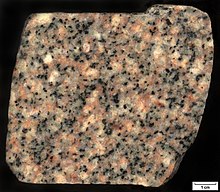
Back مونزونيت كوارتزي Arabic Adamelit Azerbaijani Quarsomonzonita Catalan Adamelita Spanish Ադամելիտ Armenian Adamelliti Italian Kvartsmonzonitt NB Kwarcowy monzonit Polish Adamelito Portuguese Kvarcmonconit Serbo-Croatian
| Igneous rock | |
 Quartz monzonite bedrock from a USGS drill core at western Cape Cod, Massachusetts |

Quartz monzonite is an intrusive, felsic, igneous rock that has an approximately equal proportion of orthoclase and plagioclase feldspars. It is typically a light colored phaneritic (coarse-grained) to porphyritic granitic rock. The plagioclase is typically intermediate to sodic in composition, andesine to oligoclase. Quartz is present in significant amounts. Biotite and/or hornblende constitute the dark minerals. Because of its coloring, it is often confused with granite, but whereas granite contains more than 20% quartz, quartz monzonite is only 5–20% quartz. Rock with less than five percent quartz is classified as monzonite. A rock with more alkali feldspar is a syenite whereas one with more plagioclase is a quartz diorite.[1] The fine grained volcanic rock equivalent of quartz monzonite is quartz latite.[1]
The term adamellite was originally applied by A. Cathrein in 1890 to orthoclase-bearing tonalite (likely a granodiorite) at Monte Adamello, Italy, in 1890, but later came to refer to quartz monzonite. The term is now deprecated.[2]
Quartz monzonite porphyry is often associated with copper mineralization in the porphyry copper ore deposits.[3]
- ^ a b Classification of Igneous Rocks Archived September 30, 2011, at the Wayback Machine
- ^ Streckeisen, A. (1 March 1976). "To each plutonic rock its proper name". Earth-Science Reviews. 12 (1): 1–33. doi:10.1016/0012-8252(76)90052-0.
- ^ Titley, Spencer R. and Carol L. Hicks, Geology of the Porphyry Copper Deposits, University of Arizona Press, 1966, p. 35